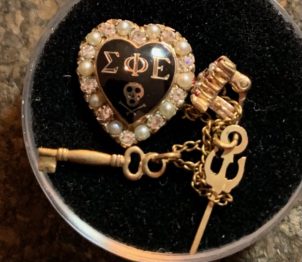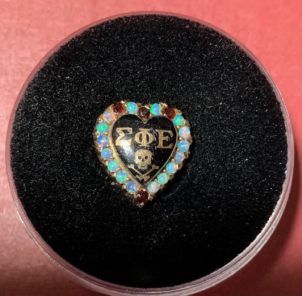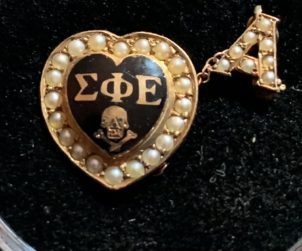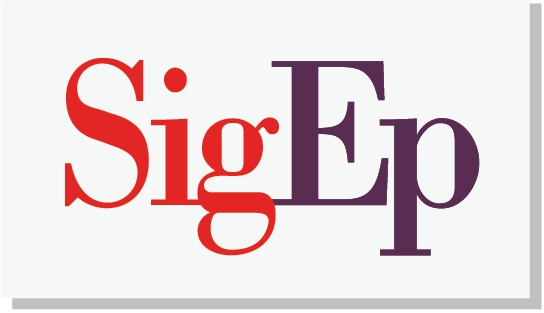Of SigEp’s many treasured symbols, the badge perhaps has the greatest significance. The original SigEp badges, crafted for our founders during the early days of the Fraternity, served as a tangible reminder of their lifelong commitment to the ideals that first brought them together at the University of Richmond. These first badges were heart shaped and made of yellow gold, with rubies and garnets alternating around the edge. Other chapters soon adopted the tradition, with many incorporating their own variations in design.
 Today, every member receives a Balanced Man Pin upon joining and wears it as an outward symbol of their membership. As fashions have changed over the decades, badges — which used to be worn frequently — have become more of a keepsake that’s worn on special occasions. Yet to a small, but active group of SigEp collectors, badges continue to hold great meaning, both for their history and as a representation of fraternal pride. Sometimes when brothers pass away, the family will send their loved one’s badge to SigEp Headquarters or give it to his chapter. But it’s not unusual for badges and other Fraternity-related items to be put up for sale online or at estate sales, which is how collectors typically find them.
Today, every member receives a Balanced Man Pin upon joining and wears it as an outward symbol of their membership. As fashions have changed over the decades, badges — which used to be worn frequently — have become more of a keepsake that’s worn on special occasions. Yet to a small, but active group of SigEp collectors, badges continue to hold great meaning, both for their history and as a representation of fraternal pride. Sometimes when brothers pass away, the family will send their loved one’s badge to SigEp Headquarters or give it to his chapter. But it’s not unusual for badges and other Fraternity-related items to be put up for sale online or at estate sales, which is how collectors typically find them.
“I’ve always been fascinated by Greek jewelry,” said Bill Davenport, Mississippi ’69, who has a collection of roughly 300 badges from SigEp and other Greek organizations. His oldest badges date back to the early 1900s. He enjoys identifying the time period in which each individual badge was produced and is particularly thrilled to find badges with the year engraved on the back.
Collecting also provides him with a nostalgic connection to the Fraternity. To Davenport, wearing the badge is a way to make a statement about your affiliation and serves as an advertisement for the wearer’s organization.
“From the day I was initiated to the day I graduated, there was not a day that went by that I didn’t wear my Fraternity pin,” he said. “The first thing I did every day was put on a clean shirt and put on my Fraternity pin.”
 Steven Dorth, Dayton ’92, also began his collection because of his interest in Fraternity history. Dorth, who has been collecting for around 20 years, has close to 100 SigEp badges.
Steven Dorth, Dayton ’92, also began his collection because of his interest in Fraternity history. Dorth, who has been collecting for around 20 years, has close to 100 SigEp badges.
While there are thousands of badges from different organizations available through estate sales and auction sites, the collectors say they’re not motivated by a need to amass the biggest collection.
“I know people who have drawers full of pins, but how many do you want?” Davenport asked.
“Fraternity history has always been a passion of mine,” Dorth said. “I thought there was a good opportunity to collect badges, especially those with historical significance.”
He noted that many of the badges he’s collected are engraved on the back with a name or a chapter or initiation date. Those are the most precious, he said, because the engravings show they’re not just random pieces of jewelry, but that they’re connected to real brothers and their stories.
“Every badge is a brother. Each one of these represents a life,” Dorth stated. “To me, it’s a shame when you find one that’s not engraved because you don’t really know much about it.”
 Dorth recently gave a couple of those unengraved badges new life. When a younger cousin was initiated into the Fraternity, he gifted one of the badges in his collection to him. When he learned of another brother who was about to graduate and didn’t have a badge, Dorth gave him one dating from 1916.
Dorth recently gave a couple of those unengraved badges new life. When a younger cousin was initiated into the Fraternity, he gifted one of the badges in his collection to him. When he learned of another brother who was about to graduate and didn’t have a badge, Dorth gave him one dating from 1916.
Although he enjoys collecting SigEp badges, Dorth said a big part of his motivation is keeping the badges out of the hands of buyers who just purchase them for the gold and jewels.
“My main goal is preserving history. I’d be sad to know my badge had been destroyed,” he stated. “I’m a steward, and they’re temporarily under my care. As I look at them and appreciate them, it’s fun to think about the brothers who may have owned them.”









Leave a Reply